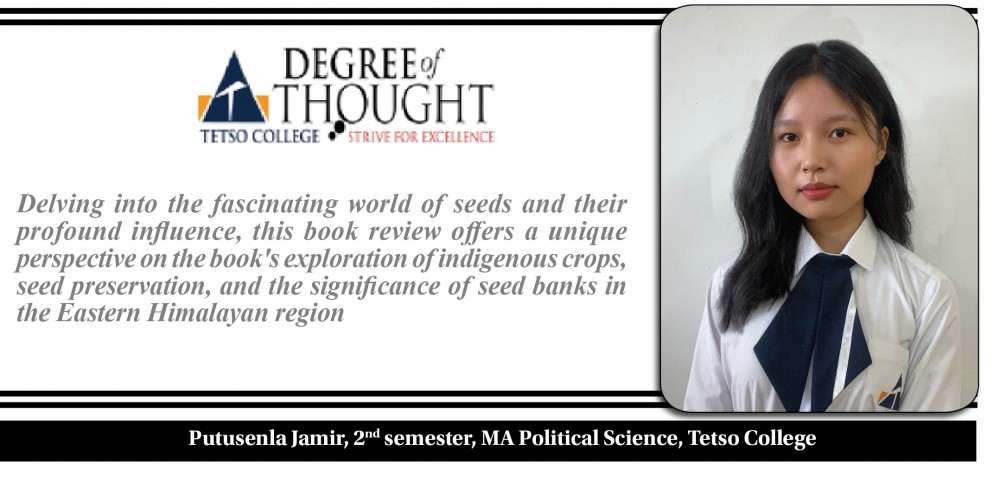
Putusenla Jamir, 2nd semester, MA Political Science, Tetso College
Something so simple yet so thought-provoking and profound. This was my first impression of the book “Seeds and Food Sovereignty: Eastern Himalayan Experiences,” a compilation of reports and write-ups by several scholars and researchers: Dolly Kikon, Dixita Deka, Joel Rodrigues, Bengt G Karlsson, Sanjay Barbara, and Meenal Tula. While reading the title, I wondered why I hadn't thought of this concept myself because it seemed so interesting. Usually, when we talk about seeds or mention the word seed, the first thought that comes to mind is “life.” But these tiny little living things and their potential are not part of our daily conversations. Hence, when I read the title and contents, I was amazed at how diverse this little thing can be and how it can impact the lives of human beings and disrupt or improve the ecological balance. This tiny seed has the capability of turning someone’s life around and bringing communities and people together. What also struck me was the focus given to the Eastern Himalayas. I was excited to read about the different types of seeds and foods that are found in this region—foods that existed before the intervention of science and technology. I’ve always been so keen on learning more about our region, and hence the mention of Chizami village in the Phek district of Nagaland, the Khasi Hills, Haa Valley in Bhutan, North Bengal, Sikkim, etc. kept me intrigued and fascinated.
The book sheds light on the various indigenous crops found in the region and how the people traditionally preserve these seeds. Unfortunately, many of these indigenous seeds have gone extinct or are endangered due to low demand and a lack of cultivation. Why low demands? The people in the region have adapted to the crops that were introduced during the colonial period. We prefer eating white rice over brown, barely, millet, etc., and potatoes and carrots instead of yams and taro. On top of that, farmers choose to grow non-indigenous crops because they are more profitable and provide a more lucrative income. These crops are also modified to give better yields and are more resistant to climate change and pests. It is only natural that they would gravitate towards these cash crops instead.
The book also does an excellent job of highlighting the importance of seed banks, a new concept for me, and the chapters explaining the same were an interesting read. The Chizami Seed Bank in Phek was founded and administered by volunteers from the Chizami Women's Society, and their primary method of seed preservation is to keep seeds in circulation to prevent deterioration. The conversation between Dr Dixita Deka and Dr Sharmila Dutta Deka was very insightful and in-depth, allowing the readers to gain more knowledge of seed banks and preservation, methods of modification, and farmers' involvement in seed preservation projects.
The emergence of seed banks and libraries in the Eastern Himalayan region is a new phenomenon that has been contributing to the protection and preservation of seeds, sharing seed knowledge, and initiating conversations on climate change and food sovereignty. The story of Mohan Chandra Borah and his journey to build the first seed library in Northeast India, the Annapurna Seed Library, was inspiring and insightful. The first seed library in Bangladesh is located in Talanda Ananda Mohan High School, and it is such an important initiative that allows the students to learn about varieties of seeds and also participate in the preservation process.
Although the book questions the relevance of indigenous crops and whether these crops will stand the test of time as well as the idea of food sovereignty, it also highlights efforts of several passionate individuals who are trying to change the way we view heirloom crops and their success story.
It also mentions the possible rise of millet and barley as popular crops in the past few years because of their nutritional value and the impact of the health-driven diet culture. These dietary transitions and developments could lead to an increase in the demand for indigenous crops. Besides, many farmers are successfully experimenting with new crops, fruits, and vegetables such as strawberries, kiwi, dragon fruits, etc. These niche farms can not only support the local economy by supplying various local vendors and businesses, but they can also spark many entrepreneurial ideas. With globalisation and growing trends, the commercialisation and ownership of seeds are important issues tackled in the book. While the multinational companies hold patent rights to several seeds and plants, allowing them to have control over the food chain, their focus on improved varieties of seeds challenge existence of indigenous crops and leads to a decline in agro-biodiversity. However, in order to have food sovereignty, many community organisations, farmer movements, and individuals are challenging the corporate control and commodification of seeds. Through enhancing local control over agriculture, the people’s right to nutritious and culturally appropriate food is ensured.
While reading the book, I found myself relating to a lot of the stories. Although my family doesn’t own any farms and we live a pretty suburban lifestyle, the stories during the COVID-19 pandemic about people getting interested in growing their own crops and eventually turning them into businesses, reminded me of how I also started a kitchen garden with my parents during the first lockdown, watching YouTube tutorials on soiling and germinating. It was fun while it lasted, but eventually, we went back to previous lifestyle. It never occurred to me that there was so much possibility in planting one seed and watching the plant grow. The book has opened my eyes to a newer perspective on looking at things; for example, as a kid, Jhum cultivation was synonymous with deforestation. That’s all that we were taught; however, jhum cultivation can be sustainable and, in fact, beneficial for the flora and fauna, replenishing the nutrients back into the soil. It can also allow farmers to grow more than one or two crops and have variety on their land. Every method has its pros and cons, and we cannot completely determine what's perfect and what’s not.
Everything begins with a seed. There was a particular line, “We are in the blessed land. If we throw seeds of any food crop, it grows... sometimes even without nurturing,” by Visonyü Liesietsu, which made me think of all the times I threw seeds in the compost pit or backyard and noticed them growing without any nurturing. Our land is truly blessed, and we should not take it for granted. You and I might not own acres of land to cultivate and farm, but I believe that with collective effort, everyone can be involved in this seed-saving project. Kitchen gardens, balcony/rooftop gardens, etc., or if that doesn’t seem a viable option, buying from local farmers and vendors and trying out indigenous recipes and food can keep the demands up for local crops and thus allow the indigenous seeds to thrive.
The book was very informative and in-depth and did an excellent job of exploring and portraying the different regions of the Eastern Himalayan region, their problems, and the unique food culture. It keeps the readers interested and intrigued with several visual illustrations. The interview format was easy to read and provided the readers with a better understanding of the conversations between the interviewer and the interviewee. The book also sheds light on the struggles of local farmers and how they manage to keep their occupation afloat by adapting to new changes and experimenting with various methods of farming and irrigation processes. The readers can thus gain a new form of appreciation for farmers. It gives the farmers a platform to showcase their hard work and ingenuity, and they should be proud of generations of passing down the land, seeds, and effective farming practices. This gives the farmers food sovereignty, as they produce crops in a sustainable manner, and continue to preserve and use multiple indigenous seeds. Finally, the readers can dwell on the aspiration, hopes, and wisdom that seed visionaries, farmers, and traditional knowledge keepers seek to offer.
The Degree of Thought Column is a weekly community column initiated by Tetso College in partnership with The Morung Express. The column explored contemporary social, cultural, political, and educational issues and challenges around us. However, the views expressed here do not reflect the opinion of the institution. Tetso College is a NAAC-accredited, UCG-recognized Commerce and Arts college. Currently, the Degree of Thought Column is managed by the department of Mass Communication, and the editorial team are Dr Jenny Lalmuanpuii, KC Gabriela and Rinsit Sareo. For feedback or comments, please email:
dot@tetsocollege.org.






